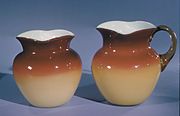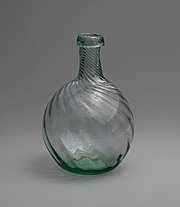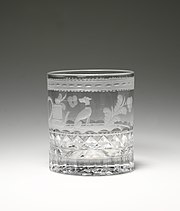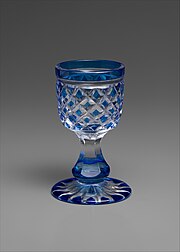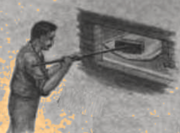Glass tubes are mainly cylindrical hollow-wares. Their special shape combined with the huge variety of glass types, allows the use of glass tubing in many applications. For example, laboratory glassware, lighting applications, solar thermal systems and pharmaceutical packaging to name the largest.

Venetian glass is glassware made in Venice, typically on the island of Murano near the city. Traditionally it is made with a soda–lime "metal" and is typically elaborately decorated, with various "hot" glass-forming techniques, as well as gilding, enamel, or engraving. Production has been concentrated on the Venetian island of Murano since the 13th century. Today Murano is known for its art glass, but it has a long history of innovations in glassmaking in addition to its artistic fame—and was Europe's major center for luxury glass from the High Middle Ages to the Italian Renaissance. During the 15th century, Murano glassmakers created cristallo—which was almost transparent and considered the finest glass in the world. Murano glassmakers also developed a white-colored glass that looked like porcelain. They later became Europe's finest makers of mirrors.
Bakewell Glass is nineteenth-century glassware from Pittsburgh, Pennsylvania, produced by a company founded by Benjamin Bakewell. Bakewell's company can be found under the names ThePittsburgh Glass Manufactory, Bakewell & Page and, Bakewell, Pears & Co. Bakewell glass built a reputation of being both luxurious and utilitarian during the 80 years it was in business.

Chance Brothers and Company was a glassworks originally based in Spon Lane, Smethwick, West Midlands, in England. It was a leading glass manufacturer and a pioneer of British glassmaking technology.

Plate glass, flat glass or sheet glass is a type of glass, initially produced in plane form, commonly used for windows, glass doors, transparent walls, and windscreens. For modern architectural and automotive applications, the flat glass is sometimes bent after production of the plane sheet. Flat glass stands in contrast to container glass and glass fibre.

The history of glass-making dates back to at least 3,600 years ago in Mesopotamia. However, most writers claim that they may have been producing copies of glass objects from Egypt. Other archaeological evidence suggests that the first true glass was made in coastal north Syria, Mesopotamia or Egypt. The earliest known glass objects, of the mid 2,000 BCE, were beads, perhaps initially created as the accidental by-products of metal-working (slags) or during the production of faience, a pre-glass vitreous material made by a process similar to glazing. Glass products remained a luxury until the disasters that overtook the late Bronze Age civilizations seemingly brought glass-making to a halt.

Glass art refers to individual works of art that are substantially or wholly made of glass. It ranges in size from monumental works and installation pieces to wall hangings and windows, to works of art made in studios and factories, including glass jewelry and tableware.
Early American molded glass refers to glass functional and decorative objects, such as bottles and dishware, that were manufactured in the United States in the 19th century. The objects were produced by blowing molten glass into a mold, thereby causing the glass to assume the shape and pattern design of the mold. When a plunger rather than blowing is used, as became usual later, the glass is technically called pressed glass. Common blown molded tableware items bearing designs include salt dishes, sugar bowls, creamers, celery stands, decanters, and drinking glasses.

Hartford City Glass Company was among the top three window glass manufacturers in the United States between 1890 and 1899, and continued to be one of the nation's largest after its acquisition. It was also the country's largest manufacturer of chipped glass, with capacity double that of its nearest competitor. The company's works was the first of eight glass plants that existed in Hartford City, Indiana during the Indiana Gas Boom. It became the city's largest manufacturer and employer, peaking with 600 employees.
Seneca Glass Company was a glass manufacturer that began in Fostoria, Ohio, in 1891. At one time it was the largest manufacturer of blown tumblers in the United States. The company was also known for its high-quality lead (crystal) stemware, which was hand-made for nearly a century. Customers included Eleanor Roosevelt and Lyndon B. Johnson, and retailers such as Marshall Field and Company, Neiman Marcus, and Tiffany's.
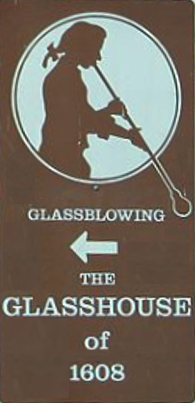
Early glassmaking in the United States began in Colonial America in 1608 at the Colony of Virginia near Jamestown, believed to be the first industrial facility in what would later become the United States. For centuries, glassmaking procedures, techniques, and recipes were kept secret, with countries actively preventing glassmaking knowledge from spreading beyond their borders. German workers with glassmaking knowledge, described as Dutchmen, along with Polish glass workers, were brought to Colonial America to begin operations. Although glass was made at Jamestown, production was soon suspended because of strife in the colony. A second attempt at Jamestown also failed.
J. H. Hobbs, Brockunier and Company was one of the largest and best-known manufacturers of glass in the United States during the 19th century. Its products were distributed worldwide. The company is responsible for one of the greatest innovations in American glassmaking—an improved formula for lime glass that enabled American glass manufacturers to produce high-quality glass at a lower cost. The firm also developed talented glassmakers that started glass factories in Ohio and Indiana.
Indiana Glass Company was an American company that manufactured pressed, blown and hand-molded glassware and tableware for almost 100 years. Predecessors to the company began operations in Dunkirk, Indiana, in 1896 and 1904, when East Central Indiana experienced the Indiana gas boom. The company started in 1907, when a group of investors led by Frank W. Merry formed a company to buy the Dunkirk glass plant that belonged to the bankrupt National Glass Company. National Glass was a trust for glass tableware that originally owned 19 glass factories including the plant in Dunkirk. National Glass went bankrupt in 1907, and its assets were sold in late 1908.
The Nickel Plate Glass Company was a manufacturer of tableware, lamps, and bar goods. It began operations in Fostoria, Ohio, on August 8, 1888, on land donated by the townspeople. The new company was formed by men from West Virginia who were experienced in the glassmaking business, and their company was incorporated in that state in February of the same year. They were lured to northwest Ohio to take advantage of newly discovered natural gas that was an ideal low-cost fuel for glassmaking. The company name came from the New York, Chicago and St. Louis Railroad, commonly known as the "Nickel Plate Road", which had tracks adjacent to the new glass plant.
Mambourg Glass Company was a window glass manufacturer that began production on October 26, 1887. The company was the first of thirteen glass manufacturers located in Fostoria, Ohio, in the United States, during northwest Ohio's gas boom. The plant was managed by Leopold Mambourg, a Belgian immigrant and experienced glassmaker. Much of the company's work force was also from Belgium. Former Ohio governor Charles Foster was president of the company and a major financial backer. He was also a major investor in other businesses and two additional Fostoria window glass companies: the Calcine Glass Company and the Crocker Glass Company. Mambourg was the chief operating officer for all three of Foster's window glass companies.
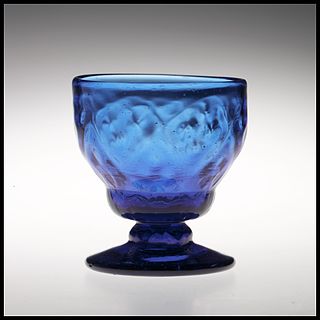
18th century glassmaking in the United States began before the country existed. During the previous century, several attempts were made to produce glass, but none were long-lived. By 1700, it is thought that little or no glass was being produced in the British colonies that would eventually become the United States. The first American glass factory operated with long–term success was started by Caspar Wistar in 1745—although two glass works in New Amsterdam that operated in the previous century deserve honorable mention. Wistar's glass works was located in the English colony known as the Province of New Jersey. In the southeastern portion of the Province of Pennsylvania, Henry Stiegel was the first American producer of high–quality glassware known as crystal. Stiegel's first glass works began in 1763, and his better quality glassmaking began in 1769. In the United States, the first use of coal as a fuel for glassmaking furnaces is believed to have started in 1794 at a short-lived factory on the Schuylkill River near Philadelphia. In 1797 Pittsburgh's O'Hara and Craig glass works was also powered by coal, and it contributed to the eventual establishment of Pittsburgh as a leading glassmaking center in the 19th century.

Very few 19th Century glassmaking innovations in the United States happened at the beginning of the century. Only ten glass manufacturers are thought to have been operating in 1800. High-quality glassware was imported from England, and glassmaking knowledge was kept secret. England controlled a key ingredient for producing high–quality glassware and kept its price high—making it difficult for American glass manufacturers to compete price-wise. European glassmakers with the knowledge to produce high–quality glassware were, in some cases, smuggled to the United States. Eventually the American glass industry grew, and the second half of the century saw numerous innovations.

19th century glassmaking in the United States started slowly with less than a dozen glass factories operating. Much of the nation's better quality glass was imported, and English glassmakers had a monopoly on major ingredients for high–quality glass such as good–quality sand and red lead. A tariff and the War of 1812 added to the difficulties of making crystal glass in America. After the war, English glassmakers began dumping low priced glassware in the United States, which caused some glass works to go out of business. A protective tariff and the ingenuity of Boston businessman Deming Jarves helped revive the domestic glass industry.
Bakewell, Pears and Company was Pittsburgh's best known glass manufacturer. The company was most famous for its lead crystal glass, which was often decorated by cutting or engraving. It also made window glass, bottles, and lamps. The company was one of the first American glass manufacturers to produce glass using mechanical pressing. In the 1820s and 1830s, Bakewell glassware was purchased for the White House by presidents James Monroe and Andrew Jackson. Founder Benjamin Bakewell is considered by some to be father of the crystal glassware business in the United States.

Sulphide portrait glassware is blown, cut, and molded glassware usually made from lead crystal that encases an image. The image appears silver or white, as if made from silver sulphide. Although sulphide is used to describe glass decorated in this manor, the silver or white image is actually a clay paste. This glass decorating style was created in Europe during the late 18th century. In the United States, Pittsburgh glass manufacturer Bakewell, Page and Bakewell was the main manufacturer of sulphide portrait glassware in the United States during the 1820s. At that time, the ornamentation style was known as cameo–incrustation or crystallo ceramie. This type of glassware became popular again during the middle of the 19th century.
